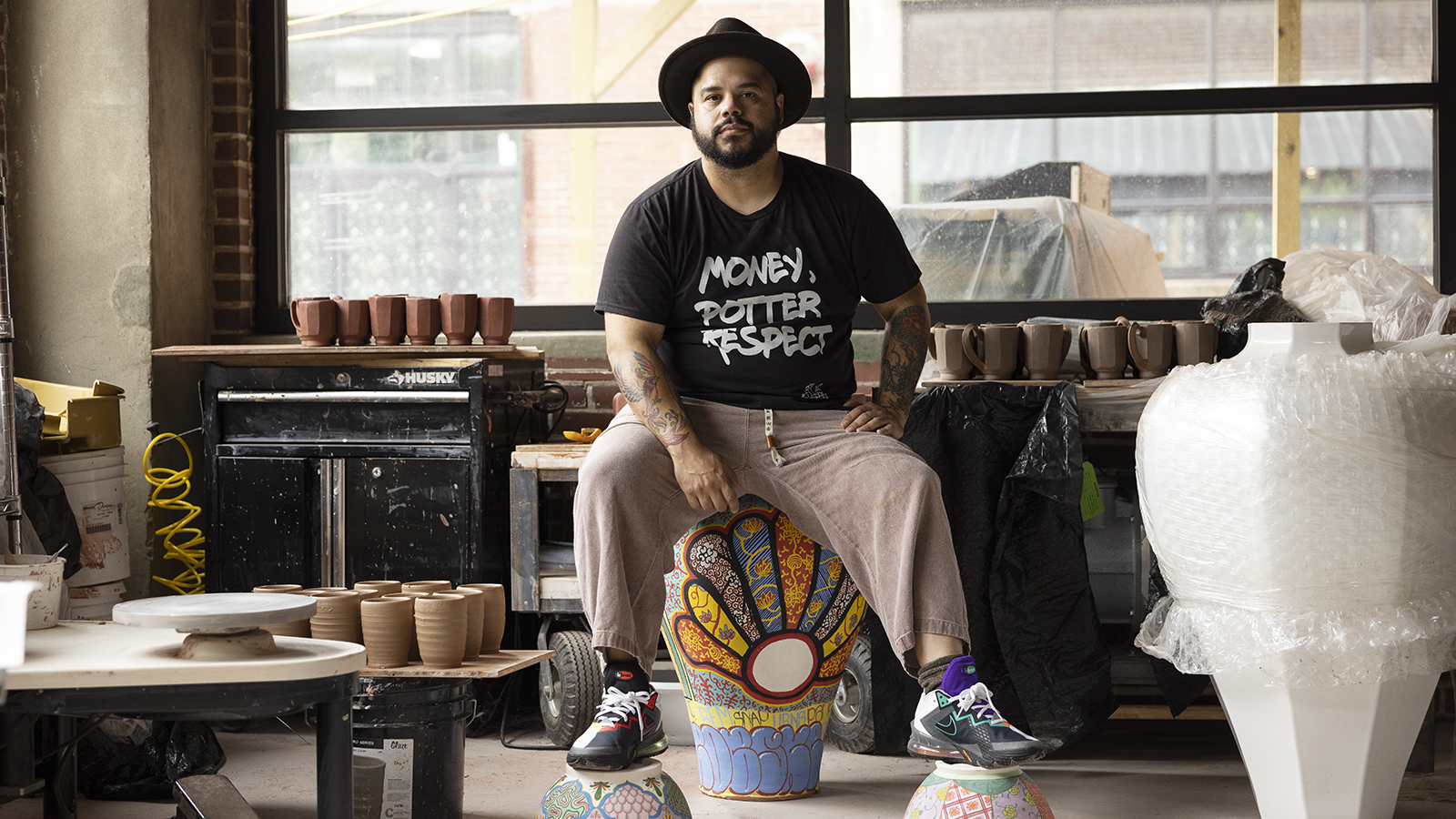Q&A with Roberto Lugo
The celebrated artist discusses his upcoming exhibition at R & Company
One of the most lauded artists of his generation, ceramicist and activist Roberto Lugo has work in the permanent collections of more than 30 leading museums throughout the United States and has contributed to numerous prestigious group exhibitions, including the Metropolitan Museum of Art’s Afrofuturism Room. On the eve of his first solo New York show, The Gilded Ghetto, opening at R & Company on September 7, the Philadelphia-based cultural force sat down to discuss his current body of work.
What can we look forward to seeing in the upcoming show?
This is a very personal exhibition for me, the first time I’m predominantly sharing stories from my life—the neighborhood I grew up in, the racism I faced as a kid—instead of doing portraiture of other people. I’m communicating in a more direct and literal way, whereas before, it was about my role as a potter and commemorating others.
It’s rare for those experiences to be told in an art-world context. I want people to find themselves represented in institutions, to have moments where they feel seen.
What prompted the shift to a more personal expression?
I’ve finally developed the autonomy to speak this way, which I previously hadn’t felt able to do. When I first started to make artwork and talk about my life, it was worrying for my family. Nobody wants their full story out there—telling people we grew up poor and had traumas. But through the process of becoming an artist, my family became really proud, and now they think it’s cool to see their story told.
How do you decide what stories to tell?
I think about what I wish I could’ve seen in museums when I was a student. Once I had a security guard job across the street from the Philadelphia Museum of Art, and I would sit on the steps and eat my lunch there, but I never went inside because I didn’t think there was anything for me. Now I have a piece in the Philadelphia Museum, but the first time I went to visit it was probably only the third time I’d ever gone inside.
It’s human instinct to want to see yourself reflected in art—which people like me do not typically experience. This is my way of doing that, putting myself “inside” traditional pieces to see myself reflected. Through that process, there’s bigger implications—other people can put themselves in the artwork, too. That becomes an effect of the work rather than its initial intent.
You’re moving from portraits into more narrative imagery?
Yes. The iconography is very specific to where I come from. A fire hydrant means one thing to one person, but if you come from my neighborhood, fire hydrants are an amusement park—and sometimes a shower. But somebody who grew up in New England could imagine playing in sprinklers as a kid and comparing that experience to a city kid playing in a fire hydrant. Moments that are very personal become universal when framed this way.
What initially drew you to portraiture?
Growing up in Philadelphia, my art history was the murals in the streets, mostly portraits of civil rights heroes and famous people of color, so when I started to make art, it was very genuine for me to fall into that tradition.
As an undergraduate, I was confronted with a lot of passive-aggressive racism: people who didn’t recognize me asked to see my ID or what I was doing there. Since I wasn’t white, I couldn’t do the thing I had in my mind, which was to be a functional potter. If you’re the first, or if you’re unlike most people in a field, you’ll be viewed as a spectacle in some ways. I had to somehow be in conversation with the experience I was having and that’s when I started to put portraits on pots: first a self-portrait, then representations of those who paved the way for me to be here.
How does your personal heritage play out in your work?
My parents grew up poor in rural Puerto Rico. We were not people worthy of having this documented lineage of ancestry, but according to my DNA, I’m one quarter each of African, indigenous Puerto Rican (or Taíno Indian), Portuguese, and Spanish, with a few other things mixed in. The indigenous and African part of my ancestry is what I empathize with. The slave trade and what happened to the Native Americans of Puerto Rico—that still affects me today, and how I grew up.
How has the growth of your studio over the years impacted your work?
Having a team has allowed me to work faster. Many of the ideas in my head take time and patience to get out and express the way I want. Having people around me who can use their varied skills to get across a specific idea visually has made the work more effective. A great example is the della Robbia [medallion] I’m working on. The portraits are [modeled] by one of my studio assistants, Charlie Cunningham, who was trained in very traditional figure-sculpting methods. Having somebody with that technical aptitude helps me create work that more exactly resembles what’s in my head.
Communicating ideas, concepts, and aesthetics as a community is how many potters and movements throughout history operated. That’s what I’m trying to achieve through my current studio process, having this community around me.
Roberto Lugo: The Gilded Ghetto opens September 7, 2023, at 64 White Street.
